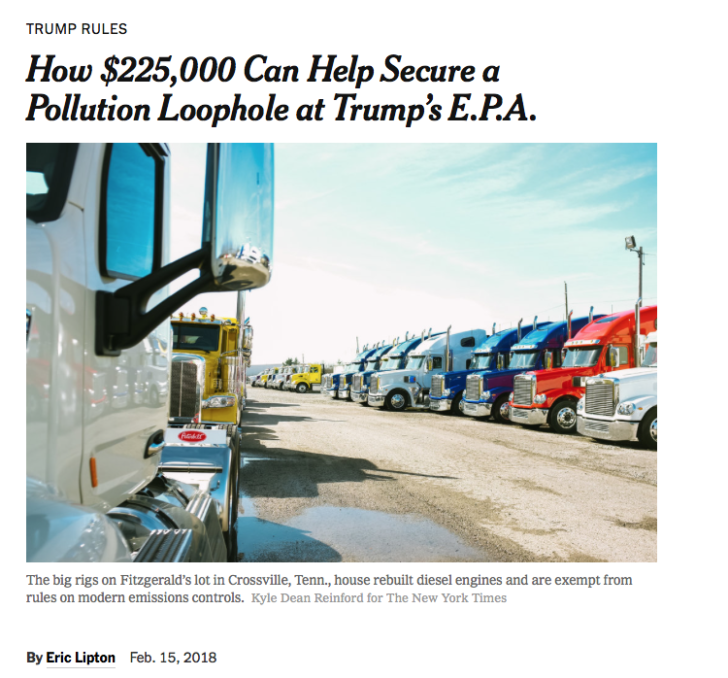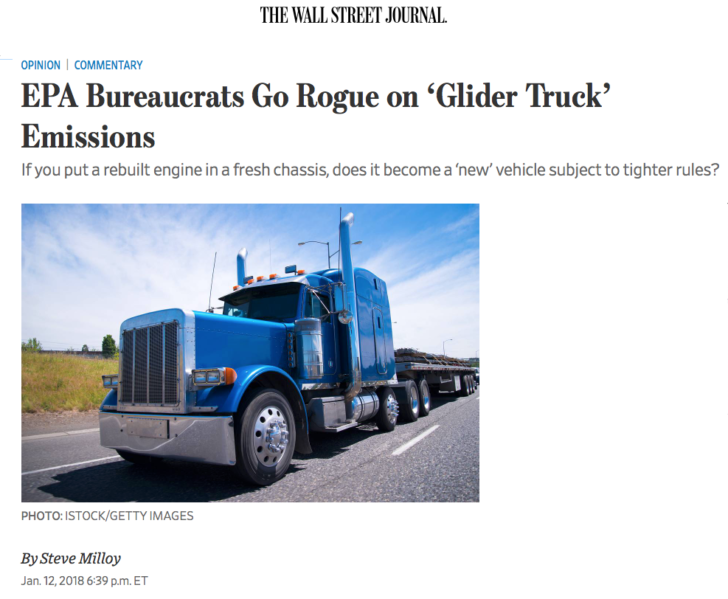New York Times hack Eric Lipton tries to save the rentseekers and rogue EPA staffers on the losing end of the glider truck controversy. But my Wall Street Journal column already revealed the inconvenient truth about the conspiracy against gliders.

Here is Lipton’s hatchet job.
My op-ed in the Wall Street Journal (print edition for January 13, 2018) is below. It is the true story of how the Obama EPA was persuaded by the new truck industry to destroy the tiny “glider truck” industry and how the Trump EPA rode to the rescue.

The Wall Street Journal edition is online here (subscription required).
The unedited, more complete version with links is below.
###
Despite Swamp, Entrepreneur to Keep on Trucking
By Steve Milloy
Tommy Fitzgerald went from living in an abandoned 1962 Ford school bus in Kentucky to founding a $700 million business selling so-called “glider trucks.” Success enabled him to become an angel investor for local businesses in rural Kentucky and Tennessee.
But instead of encouraging, if not celebrating these accomplishments, the Obama administration issued regulations designed to put Fitzgerald out of business and kill thousands of glider truck industry-dependent jobs nationwide.
Fortunately for Fitzgerald, elections have consequences, like President Trump’s regulatory rollback and Environmental Protection Agency chief Scott Pruitt’s implementation of that policy.
Glider trucks are a godsend to smaller trucking companies that can’t afford pricey new trucks, which are constantly being made even pricier by ever-tightening emissions regulations. Fitzgerald, who spent his early days as a mechanic and truck driver, discovered in 1989 in his one-bay Tennessee service center that he could take a salvageable drivetrain from a wrecked truck, rebuild it, add on a new cab-chassis and then sell what is almost a new truck — a “glider” truck — for about 25 percent less than the cost of an totally new truck.
Fitzgerald’s innovation took off, creating a market of about 5,000 glider truck sales annually, two-thirds of which are his.
Although the glider market is tiny compared to the approximately 300,000-vehicle-per-year new truck market, and although new truck makers sell the new cab-chasses components to glider makers, some in the new truck industry see gliders as a threat to be eliminated. Enter the Obama EPA.
Led by the likes of Volvo and trade groups, rulemaking documents show the new truck industry urged the Obama EPA in 2016 to add gliders to a then-ongoing rulemaking regulating truck greenhouse gas emissions. The problem, however, was the Clean Air Act only authorizes EPA to regulate emissions from new trucks and gliders are not new trucks. But that didn’t stop the Obama EPA.
Ignoring that glider truck engines (the part responsible for emissions) are used and then rebuilt, EPA claimed gliders could be considered as new because the truck’s cab-chassis is new. The agency supported its reasoning by citing a single ad in a trade magazine reading, “Fitzgerald Glider Kits offers customers the option to purchase a brand new 2016 tractor… Fitzgerald has mastered the process of taking the ‘Glider Kit’ and installing the components to work seamlessly with the new truck.’’ [Emphasis added] But EPA conveniently omitted the ad’s next sentence, which read, “The end result is a brand new glider with an engine and transmission that has been completely rebuilt from the ground up.”

The Obama EPA concluded that “reasonable judgments must be made, and in this case, the agency believes it reasonable that the tail need not wag the dog.” So in October 2016, EPA issued its rule classifying gliders as new trucks. The rule would have essentially shuttered the glider industry. While gliders can outperform new trucks on some emissions tests, they underperform on others and so would violate EPA standards. Enter Trump EPA chief Scott Pruitt.
In July 2017, Fitzgerald petitioned the EPA to reverse the Obama EPA rule on the grounds that gliders aren’t new trucks. Citing authority granted by several Supreme Court cases — including the 2005 decision in National Cable & Telecommunications. Association v. Brand X Internet Services which held “a change in administration brought about by the people casting their votes is a perfectly reasonable basis for an executive agency’s reappraisal of the costs and benefits of its programs and regulations” — EPA chief Pruitt proposed in November to rescind the rule.
But anti-glider forces, including Volvo, began re-lobbying EPA after the July filing of Fitzgerald’s petition, according to lobbying disclosure records. Somehow by October, without the knowledge or authorization of Pruitt according to EPA staff, an EPA laboratory in Ann Arbor, MI ran two glider trucks through an emissions testing protocol. The resulting report, also released without the knowledge or approval of Pruitt, concluded the tested gliders exceeded new truck emissions of nitrogen oxide, particulate and other conventional pollutants.
Neither the report’s process nor its results, however, salvage its sketchy origin. It was not peer reviewed. It was not printed on official EPA letterhead or assigned an internal EPA document number. It is not even available on the EPA lab’s web site. But it was mysteriously made available to be cited by glider opponents in the early December public hearing on the proposed rollback. The report does not reveal the origins of the two tested gliders. It further indicates that one truck was run with its engine harness full of oil and its “Check Engine” light on. It was hardly a fair test.
Yet there is much irony in that the tested gliders had lower greenhouse gas emissions than new trucks — the emissions that were the original reason EPA wanted to regulate gliders as new trucks.

The effort to destroy the glider truck industry should be more than just another example of the regulatory state gone rogue.
Philip K. Howard wrote in the Wall Street Journal recently that bureaucrats protected by civil service protections are powerful, yet often unaccountable. They can, with virtual impunity, thwart the legal authority of a President to implement his own policies.
As Fitzgerald put it, “In the business world, employees who actively seek to undermine are usually terminated for insubordination. Why should it be different for government?”
Steve Milloy was on the Trump EPA Transition Team and is the author of “Scare Pollution: Why and How to Fix the EPA” (Bench Press, 2016).